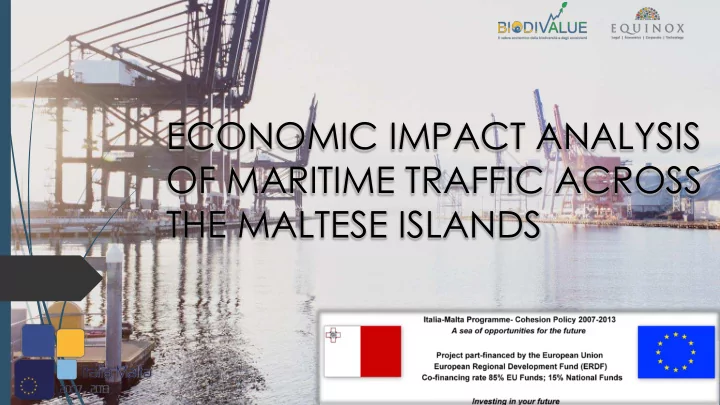

ECONOMIC IMPACT ANALYSIS OF MARITIME TRAFFIC ACROSS THE MALTESE ISLANDS
THE PROJECT ABOUT POLLUTION THE METHOD WHY The project idea is to create operational tools to support local administrators and operators of maritime traffic. Study and analysis of maritime traffic in the Strait of Sicily Biophysical consequences on flora, fauna and atmosphere Financial assessment of the negative externalities Analyse how negative effects of pollution could undermine future development.
THE PROJECT ABOUT POLLUTION THE METHOD OBJECTIVES Create 4 DATABASES of the estimated monetary value relating to the following data collected: Wp1. Water pollution caused by the discharging of toxic and polluting substances at sea; Wp2. Toxic and polluting substances contaminating marine sediments ; Wp3. The loss of biodiversity due to the introduction of alien species in the Strait of Sicily; and Wp4. Ship generated waste collection and disposal. Relevant Geographical Areas: 1) Port of Valletta 2) Malta free port area 3) Gozo protected marina areas
THE PROJECT ABOUT POLLUTION THE METHOD POLLUTION Water pollution. The several chemical products and substances used in and transported by ships can end up in the sea, willingly or by accident, causing water pollution. Sediment Sediment contamination is strictly linked to water pollution. Contaminants can pass from water to sediments. Biodiversity Dredging can destroy the habitats of marine species and remove subtidal benthic species and communities It can also cause the resuspension of contaminants. Transfer of non-indigenus aquatic organisms with ballast water, used to stabilize vessels at sea.
THE PROJECT ABOUT POLLUTION THE METHOD Economic Emission flows Absorption of activity into the a part of the environment flow Flow pollution Non absorbed damage emission flows Degradation of Accumulation stock into of pollutant harmless forms stock Stock pollution Pollution damage damage
THE PROJECT ABOUT POLLUTION THE METHOD POLLUTION Flow of pollution occurs when pollution is emitted at a given quantity per time window. This may be thought of as the rate at which pollution is being discharged into the environment system. This model treats the environment as a system with an “ assimilative capacity ”. There is no resulting stock pollution if the residual flow rate is equal to, or less than, assimilative capacity. Stock pollution describes the quantity of pollution that there is at any one given point in time in the relevant environmental system. This is a result of previous flows and the assimilation by the underlying recipient ecosystem. Environmental protection agencies may be able to control the rate of emission flows but not pollution stocks. Even where they cannot control such flows directly, the regulator may find it more convenient to target emissions rather than stocks
THE PROJECT ABOUT POLLUTION THE METHOD ECONOMIC EVALUATION Society’s valuation of ecosystems is rooted in the services that they provide. When ecosystems are degraded or altered to the point at which their services decline, society may choose to invest in restoring the system to regain these services For environmental goods and services which are not traded in actual market, the task of finding out about people’s preferences and estimating the economic value in question is even more complex since when there is no price information .
THE PROJECT ABOUT POLLUTION THE METHOD RESTORATION COST APPROACH (WP2,WP3) The restoration cost approach values an environmental good according to the cost incurred in restoring it to its original state after it has been damaged. Restoration of ecosystems and their functions will often increase the quantity or quality of environmental services valued by humans. It is based on the assumption that, if people incur costs to avoid damages caused by lost ecosystem services, or to replace the services of ecosystems, then those services must be worth at least what people paid to replace them.
THE PROJECT ABOUT POLLUTION THE METHOD RESTORATION COST APPROACH (WP2,WP3) The steps in computing restoration costs are: Assess the environmental services provided (Specifying relevant services, how , to whom and the level provided). Identify least costly substitute for restoring services. Public demand for restoration: Requires gathering evidence that the public would be willing to accept to pay.
THE PROJECT ABOUT POLLUTION THE METHOD THE OTHER WPs WP 1 : Disaggregate the fleet Detect the factors of environmental impact for each category in order to define some average indicators Define the value unit of pressure-damage applied and carry out a specific monetary evaluation of the external costs for each category of ship transited and landed. WP 4 : Direct calculation of the waste disposal costs , as they define quantity/ typology in the unit of time for the port Area considered, and they can be used to define the direct cost parameters to be used for the costs calculation such as: € / m 3 of disposal € / ton. € / lt.
CONCLUSION Restoring ecosystems to their exact former condition is rarely experienced; however, close approximations are possible . Sustainability within ecosystems is necessary in supporting sustainable economies, according to ecological economists. This interdependency is due to the direct relationship between the economy and the capacity of the world’s ecosystems to provide resources and waste assimilation. Ecosystem restoration can play a significant role in providing greater, sustainable stocks of natural capital.
Recommend
More recommend